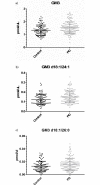Elevated GM3 plasma concentration in idiopathic Parkinson's disease: A lipidomic analysis
- PMID: 28212433
- PMCID: PMC5315374
- DOI: 10.1371/journal.pone.0172348
Elevated GM3 plasma concentration in idiopathic Parkinson's disease: A lipidomic analysis
Abstract
Parkinson's disease (PD) is a common neurodegenerative disease whose pathological hallmark is the accumulation of intracellular α-synuclein aggregates in Lewy bodies. Lipid metabolism dysregulation may play a significant role in PD pathogenesis; however, large plasma lipidomic studies in PD are lacking. In the current study, we analyzed the lipidomic profile of plasma obtained from 150 idiopathic PD patients and 100 controls, taken from the 'Spot' study at Columbia University Medical Center in New York. Our mass spectrometry based analytical panel consisted of 520 lipid species from 39 lipid subclasses including all major classes of glycerophospholipids, sphingolipids, glycerolipids and sterols. Each lipid species was analyzed using a logistic regression model. The plasma concentrations of two lipid subclasses, triglycerides and monosialodihexosylganglioside (GM3), were different between PD and control participants. GM3 ganglioside concentration had the most significant difference between PD and controls (1.531±0.037 pmol/μl versus 1.337±0.040 pmol/μl respectively; p-value = 5.96E-04; q-value = 0.048; when normalized to total lipid: p-value = 2.890E-05; q-value = 2.933E-03). Next, we used a collection of 20 GM3 and glucosylceramide (GlcCer) species concentrations normalized to total lipid to perform a ROC curve analysis, and found that these lipids compare favorably with biomarkers reported in previous studies (AUC = 0.742 for males, AUC = 0.644 for females). Our results suggest that higher plasma GM3 levels are associated with PD. GM3 lies in the same glycosphingolipid metabolic pathway as GlcCer, a substrate of the enzyme glucocerebrosidase, which has been associated with PD. These findings are consistent with previous reports implicating lower glucocerebrosidase activity with PD risk.
Conflict of interest statement
Figures


References
-
- Mattson MP (2004) Metal-catalyzed disruption of membrane protein and lipid signaling in the pathogenesis of neurodegenerative disorders. Ann N Y Acad Sci 1012: 37–50. - PubMed
MeSH terms
Substances
Grants and funding
LinkOut - more resources
Full Text Sources
Other Literature Sources
Medical

